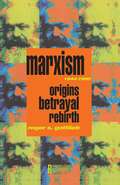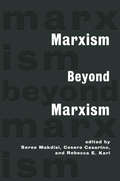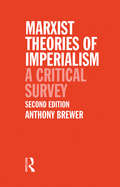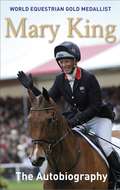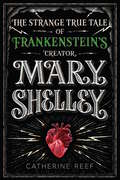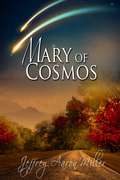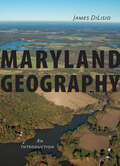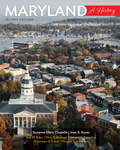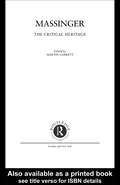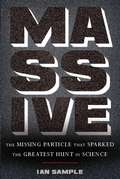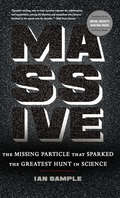- Table View
- List View
Marxism 1844-1990: Origins, Betrayal, Rebirth (Revolutionary Thought and Radical Movements)
by Roger S. GottliebFirst Published in 1992. Routledge is an imprint of Taylor & Francis, an informa company.
Marxism Beyond Marxism
by Rebecca E. Karl Saree Makdisi Cesare CasarinoThese essays critically rethink Marxism in the light of the disintegration of communist regimes Eastern Europe and the Soviet Union. Containing essays from a group of internationally distinguished writers and intellectuals, this collection addresses Marxism as a cultural-political problematic. Contending that Marxism is deeply embedded in specific cultural practices, the contributors illuminate Marxism's contribution to discussions of labour in post-industrial capitalism, to controversies surrounding compulsory heterosexuality and queer theory, and to debates about the institutionalization and academicization of the "New" Left. In examining Marxism's relationship to cultural practices, the contributors make a case for Marxism's continued relevance. By combining a diversity of perspectives, these essays demonstrate that Marxism addresses urgent needs that are often forsaken by other political and ideological practices. They show how - now more than ever - Marxism's reaffirmation can serve as a sophisticated and cunning response to the latest global developments - and travesties.
Marxist Theories of Imperialism: A Critical Survey
by Tony BrewerThe last two hundred years have seen a massive increase in the size of the world economy and equally massive inequalities of wealth and power between different parts of the world. They have also witnessed the rise to dominance of the capitalist mode of production. Marxists, from Marx himself through to present day thinkers, have argued that these changes are profoundly interconnected. This book offers a unique account of Marxist theories of Imperialism. It has been fully updated and expanded to cover all the developments since its initial publication and will be essential reading for any student of Marxism.
Mary Berry's Family Sunday Lunches
by Mary BerryMary Berry's latest book celebrates the Sunday lunch. With over 150 delicious new recipes, the queen of home cooking shows you how to roast the perfect joint, bake the most scrumptious pudding and prepare a long lunch in all seasons. From slow-cooked casseroles to light summer salads, Mary Berry's tried and tested recipes are classics you can trust. She includes all the traditional Sunday lunch recipes, including how to make the perfect Yorkshire pudding, and brings the Sunday lunch up to date with fun and new ways to delight and feed family and friends. Beautifully packaged with mouth-watering photos, this is a must for food lovers and Mary Berry fans.
Mary King: The Autobiography
by Mary KingA no-holds-barred story of what it takes to reach the top, and stay there, in the world's most dangerous sport - three day eventing.At the age of forty-seven Mary King won a Team Bronze at the Beijing Olympics. In the two 'Cavaliers' - 'Call Again Cavalier' and 'Imperial Cavalier' - she has two of the very best event horses in the world. Mary King's success in the world of eventing (now officially classed as the most dangerous sport in the world) has been hard won. She does not come from a privileged background - her father a verger and a long-term invalid so money was very tight. Her first pony was the ancient 'cast off' from the local vicar's children - and success with this pony gave her an iron will to succeed. And succeeded she has. To support herself in the early days she had a variety of unglamorous jobs (this included butcher delivery rounds and cleaning out toilets in the local campsite). Her talent was apparent from very early on and she first competed at Badminton in 1985, had her first win there on King William in 1992 and her second on Star Appeal in 2000. Just when everything seemed to be going well she suffered a terrible fall in 2001 and broke her neck but she was back competing at the very top level the following year.Fully updated for the paperback with the 2010 season, including Team GB's gold medal-winning performance at the World Equestrian Games, this is a fascinating account from inside the world's most dangerous sport.
Mary Shelley: The Strange True Tale of Frankenstein's Creator
by Catherine ReefOn the 200th anniversary of the publication of Frankenstein, comes a riveting biography of its author, Mary Shelley, whose life reads like a dark gothic novel, filled with scandal, death, drama, and one of the strangest love stories in literary history. The story of Frankenstein&’s creator is a strange, romantic, and tragic one, as deeply compelling as the novel itself. Mary ran away to Lake Geneva with the poet Percy Bysshe Shelley when she was just sixteen. It was there, during a cold and wet summer, that she first imagined her story about a mad scientist who brought a corpse back to life. Success soon followed for Mary, but also great tragedy and misfortune. Catherine Reef brings this passionate woman, brilliant writer, and forgotten feminist into crisp focus, detailing a life that was remarkable both before and after the publication of her iconic masterpiece. Includes index.
Mary of Cosmos
by Jeffrey Aaron MillerThe epic conclusion to the story that began with Mary of the Aether and continued with Mary of Shadows and Mary of Starlight. One enemy remains, a creature more devious, cunning and cruel than any Devourer. Mary the Lightbearer will face this enemy in a last world-shattering battle that will change the fate of universes. But it is a battle like no other against an evil force greater than anything Mary has ever known. The truth about many things will be revealed, and no one will ever be the same.
Mary, Will I Die?
by Shawn SarlesBestselling author Shawn Sarles' most terrifying YA horror yet . . .It starts innocently enough. Four kids - three girls, one boy - are at one of their houses, playing games. One of them has read about "Bloody Mary" and the idea that if you look into a mirror and say her name thirteen times, she will show you the future. Some legends say she'll show you your one true love or a skull to mark your death within five years. Others say that conjuring Bloody Mary will bring her into your world.Both sets of legends are true. The kids go through with the act, saying her name thirteen times. One girl looks in the mirror and sees her longtime crush. One girl looks in the mirror and sees the boy in the group. But she pretends to see something else. One girl looks in the mirror and sees a girl she's never seen before but can't get out of hermind. And the boy . . . he sees a skull. But he pretends to see something else. They try to laugh it off. And mostly they forget about it. Or at least they don't talk about it. Yes, over the next few years, whenever they look into a mirror, it's like there's always another figure standing in the background, getting closer.Just short of five years later, the four of them are no longer friends, having gone on separate paths. The girl whose house it was has always tried to avoid the mirror they used - because she always sensed someone in the background. One morning as she's passing by, she sees much more than her own reflection - it's a scary figure taunting her. She startles and breaks the mirror. When the pieces are put back together (barely), the figure is gone.That day in school, a new girl arrives. Her name is Mary . . . .
Maryland Geography: An Introduction
by James DiLisioA grand tour of Maryland’s geographic past through the lens of today’s landscape.When he first laid eyes on the countryside around Chesapeake Bay in 1608, records reveal, Captain John Smith exclaimed, "Heaven and earth seemed never to have agreed better to frame a place for man’s habitation." In Maryland Geography, James DiLisio—another admirer of the Free State—pays tribute to Maryland’s rich cultural, historical, and geographical heritage. This up-to-date, in-depth account interprets the contemporary environmental conditions of the "Marylandscape" by emphasizing its evolving political and socioeconomic contours.This closely researched volume, which is loaded with instructive charts and maps, is the result of DiLisio’s lifelong fascination with the geography of his adopted state and his thirty-five years teaching Maryland geography at Towson University. Arguing that regional geography is a product of both natural and human events, Maryland Geography provides an account of the vital geographical stage that the people of Maryland have created.DiLisio touches on Maryland’s pre-European American Indian heritage, post-colonial agriculture, and shifting industrial geography, as well as the degradation of the Chesapeake Bay and the rise of the modern economy. He considers the emergence of the isolated Eastern Shore; the rural tobacco land of southern Maryland; the rugged mining area of western Maryland; the prosperous, mixed farming area of the Piedmont; and the metropolitan Baltimore-Washington corridor. More than descriptive, the book examines major trends in the state—natural, economic, and demographic—in a way that prompts thinking about the consequences of growth and unbridled development. Aimed at college-level geography students, the book will also be of great interest to general readers, historians, politicians, and anyone involved in making policies relating to Maryland places.
Maryland: A History
by Jean H. Baker Suzanne Ellery Chapelle Jean B. Russo Constance B. Schulz Dean R. Esslinger Edward C. Papenfuse Gregory A. StiversonAn engaging and accessible introductory history of the people, places, culture, and politics that shaped Maryland.In 1634, two ships carrying a small group of settlers sailed into the Chesapeake Bay looking for a suitable place to dwell in the new colony of Maryland. The landscape confronting the pioneers bore no resemblance to their native country. They found no houses, no stores or markets, churches, schools, or courts, only the challenge of providing food and shelter. As the population increased, colonists in search of greater opportunity moved on, slowly spreading and expanding the settlement across what is now the great state of Maryland.In Maryland, historians recount the stories of struggle and success of these early Marylanders and those who followed to reveal how people built modern Maryland. Originally published in 1986, this new edition has been thoroughly revised and updated. Spanning the years from the 1600s to the beginning of Governor Larry Hogan’s term of office in January 2015, the book more fully fleshes out Native American, African American, and immigrant history. It also includes completely new content on politics, arts and culture, business and industry, education, the natural environment, and the role of women as well as notable leaders in all these fields. Maryland is heavily illustrated, with nearly two hundred photographs and illustrations (more than half of them in full color), as well as related maps, charts, and graphs, many of which are new to this book. An extensive index and a comprehensive Further Reading section provide extremely useful tools for readers looking to engage more deeply with Maryland history. Touching on major figures from George Calvert to Frederick Douglass and Harriet Tubman to William Donald Schaefer, this book takes readers on an unforgettable journey through the history of the Free State. It should be in every library and classroom in Maryland.
Massage For The Hospital Patient And Medically Frail Client
by Gayle MacdonaldThis is an essential, one-of-a-kind resource for gaining the skills and knowledge you need to provide safe, effective massage therapy to patients in acute care settings and private practice clients who are medically frail. As demand grows for massage therapy in acute care, many bodyworkers seek to broaden their ability to meet this important need. To paraphrase the author: For many touch therapists, massage is more than a job or a profession--it's a calling. With the knowledge gained from this expertly written book, you will be able to confidently provide massage therapy in the hospital, other care settings, and for clients affected by health problems. It's the ideal guide for student bodyworkers and practitioners, educators, hospital administrators, and a wide range of medical professionals.
Massage Mastery: From Student To Professional
by Anne WilliamsThis comprehensive introductory massage text is organized into 24 chapters that cover the key areas addressed in massage programs of 500 to 1200 hours in length. Topics inside the chapters are structured to allow for manageable reading assignments that build a student's sense of accomplishment and motivation. Written and designed for today's adult learner, the book offers a broad discussion of foundation massage with appropriate depth for a beginning student progressing to an entry-level professional. It also contains new topics that are necessary to prepare today's adult learners for successful massage careers. (Note: It does not cover anatomy and physiology, as A&P is best thoroughly covered in a separate textbook. ) A helpful appendix on health care terminology, a comprehensive massage glossary, and a robust set of ancillary materials complete the package. The companion Study Guide contains topic-specific Rubrics, Learning Contracts, and a variety of exercises and activities for students.
Massinger: The Critical Heritage
by Martin GarrettMartin Garrett's comprehensive collection presents and explains the history of the critical reception to Massinger's work from the early seventeenth to the late nineteenth century. The volume includes extensive selections from the writings of Pepys, Goldsmith, Coleridge, Hazlitt, Lamb and Swinburne, as well as briefer comments from Scott, Byron and Keats. Responses to Massinger's plays from writers as diverse as Boswell, Mrs Thrale, Dickens and Elizabeth Barrett Browning are discussed in Martin Garrett's introduction, which also includes an account of the plays' original political and theatrical context.
Massive
by Ian SampleThe biggest science story of our time, Massive spans four decades, weaving together the personal narratives and international rivalries behind the search for the "God" particle, or Higgs boson. A story of grand ambition, intense competition, clashing egos, and occasionally spectacular failures, Massive is the first book that reveals the science, culture, and politics behind the biggest unanswered question in modern physics-what gives things mass? Drawing upon his unprecedented access to Peter Higgs, after whom the particle is named, award-winning science writer Ian Sample chronicles the multinational and multibillion-dollar quest to solve the mystery of mass. For scientists, to find the God particle is to finally understand the origin of mass, and until now, the story of their search has never been told.
Massive
by Ian SampleA prize-winning science writerOCOs history of the forty-year search for the Higgs boson, and the intense rivalries, clashing egos, and grand ambition that led to a world-changing discovery
Massive: The Missing Particle That Sparked the Greatest Hunt in Science
by Ian SampleThe biggest science story of our time, Massive spans four decades, weaving together the personal narratives and international rivalries behind the search for the #147;God" particle, or Higgs boson. A story of grand ambition, intense competition, clashing egos, and occasionally spectacular failures, Massive is the first book that reveals the science, culture, and politics behind the biggest unanswered question in modern physics#151;what gives things mass? Drawing upon his unprecedented access to Peter Higgs, after whom the particle is named, award-winning science writer Ian Sample chronicles the multinational and multibillion-dollar quest to solve the mystery of mass. For scientists, to find the God particle is to finally understand the origin of mass, and until now, the story of their search has never been told.
Master the SAT Basics: Part I of V
by Peterson'sPeterson's Master the SAT: Basics contains essential information about all aspects of the SAT. Readers will learn about what kinds of questions to expect, how the tests are scored and reported, and how to get ready the night before and day of the test. Peterson's Master the SAT provides students with detailed strategies to help maximize their test scores AND offers hundreds of practice questions to help them prepare for test day. For more information see Peterson's Master the SAT.
Master the SAT Critical Reading: Part III of V
by Peterson'sPeterson's Master the SAT: Critical Reading helps test-takers learn about sentence completion and reading strategies while offering dozens of practice exercises. Readers will learn about the basic steps for solving sentence completion questions and understanding critical reading passages. Peterson's Master the SAT provides students with detailed strategies to help maximize their test scores AND offers hundreds of practice questions to help them prepare for test day. For more information see Peterson's Master the SAT.
Master the SAT Math: Part V of V
by Peterson'sPeterson's Master the SAT: Math gives test-takers essential strategies for multiple-choice and grid-in questions. It includes helpful reviews of numbers and operations, basic algebra, functions and intermediate algebra, geometry, data analysis, statistics, and probability. Peterson's Master the SAT provides students with detailed strategies to help maximize their test scores AND offers hundreds of practice questions to help them prepare for test day. For more information see Peterson's Master the SAT.
Master the SAT Writing: Part IV of V
by Peterson'sPeterson's Master the SAT: Writing provides an in-depth review of the SAT essay. Test-takers will find informative writing strategies, including information on multiple-choice writing questions (identifying sentence errors, improving sentences, and improving paragraphs), an explanation of the writing process and the SAT essay, and a guide to good writing, which includes vocabulary lists of irregular verbs and confusing words. Peterson's Master the SAT provides students with detailed strategies to help maximize their test scores AND offers hundreds of practice questions to help them prepare for test day. For more information see Peterson's Master the SAT.
Master the SAT: Part II of V
by Peterson'sPeterson's Master the SAT: Diagnosing Strengths and Weaknesses contains a diagnostic test designed to help test-takers assess their abilities on the SAT. The test contains critical reading, writing, and math questions-all with detailed answer explanations. In addition, there is a score sheet and a comparison chart to help test-takers pinpoint relative strengths and weaknesses. Peterson's Master the SAT provides students with detailed strategies to help maximize their test scores AND offers hundreds of practice questions to help them prepare for test day. For more information see Peterson's Master the SAT.
Master the SAT: Practice Test 2 of 6
by Peterson'sPeterson's Master the SAT: Practice Test 2 features a full-length SAT exam with detailed answer explanations. The practice test is designed to prepare test-takers for the critical reading, writing, and math questions-as well as the written essays-they will find on the actual exam. Peterson's Master the SAT provides students with detailed strategies to help maximize their test scores AND offers hundreds of practice questions to help them prepare for test day. For more information see Peterson's Master the SAT.
Master the SAT: Practice Test 3 of 6
by Peterson'sPeterson's Master the SAT: Practice Test 3 features a full-length SAT exam with detailed answer explanations. The practice test is designed to prepare test-takers for the critical reading, writing, and math questions-as well as the written essays-they will find on the actual exam. Peterson's Master the SAT provides students with detailed strategies to help maximize their test scores AND offers hundreds of practice questions to help them prepare for test day. For more information see Peterson's Master the SAT.
Master the SAT: Practice Test 4 of 6
by Peterson'sPeterson's Master the SAT: Practice Test 4 features a full-length SAT exam with detailed answer explanations. The practice test is designed to prepare test-takers for the critical reading, writing, and math questions-as well as the written essays-they will find on the actual exam. Peterson's Master the SAT provides students with detailed strategies to help maximize their test scores AND offers hundreds of practice questions to help them prepare for test day. For more information see Peterson's Master the SAT.
Master the SAT: Practice Test 5 of 6
by Peterson'sPeterson's Master the SAT: Practice Test 5 features a full-length SAT exam with detailed answer explanations. The practice test is designed to prepare test-takers for the critical reading, writing, and math questions-as well as the written essays-they will find on the actual exam. Peterson's Master the SAT provides students with detailed strategies to help maximize their test scores AND offers hundreds of practice questions to help them prepare for test day. For more information see Peterson's Master the SAT.
